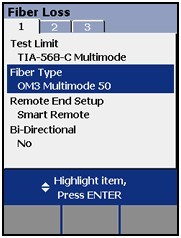|
In ANSI/TIA-568-C.3, the TIA adopted the nomenclature for fiber found in the international standard ISO/IEC 11801. The multimode fiber is prefixed with “OM” and the singlemode mode “OS”.
The new designation in ANSI/TIA-568-C.3 should alleviate some of the confusion associated with application support distance issues. Each “OM” has a minimum Modal Bandwidth (MBW) requirement.
|
|
Minimum modal bandwidth MHz.km |
|
Wavelength |
Overfilled launch bandwidth |
Effect laser launch bandwidth |
|
Fiber Type |
Core diameter |
850 nm |
1300 nm |
850 nm |
|
OM1 |
62.5 µm |
200 |
500 |
Not specified |
|
OM2 |
50 µm |
500 |
500 |
Not specified |
|
OM3 |
50 µm |
1500 |
500 |
2,000 |
|
OM4 |
50 µm |
3500 |
500 |
4,700 |
Why two values? What’s the difference between overfilled and effective? Overfilled is with an LED source, effective is with a VCSEL. New vs old. Loss length testing to ISO/IEC must be done with an LED and should be done with an LED for TIA testing.
To most users, the following table may be of more benefit:
|
1000BASE-SX |
10GBASE-S |
40GBASE-SR4 |
100GBASE-SR10 |
|
OM1 |
275 m |
33 m |
Not specified |
Not specified |
|
OM2 |
550 m |
82 m |
Not specified |
Not specified |
|
OM3 |
Not specified |
300 m |
100 m |
100 m |
|
OM4 |
Not specified |
500 m* |
150 m |
150 m |
* The IEEE has yet to officially give a distance for 10GBASE-S on OM4 fiber. The distances are decided by the IEEE in 802.3, not the TIA or ISO/IEC cabling standards. Some glass vendors say 500 m, but most are now quoting “up to 550 m”.
Cautionary note: In ANSI/TIA-568-B.3, the modal bandwidth of 62.5 µm fiber was 160 MHz.km, not the 200 MHz.km found in the current ANSI/TIA-568-C.3. This change was done to harmonize with ISO/IEC 11801. That would reduce the distance for 1000BASE-SX to 220 m and 10GBASE-S to 26 m.
There is also a loss limit associated with these distances too.
|
1000BASE-SX |
10GBASE-S |
40GBASE-SR4 |
100GBASE-SR10 |
|
OM1 |
2.60 dB |
2.5 dB |
Not specified |
Not specified |
|
OM2 |
3.56 dB |
2.3 dB |
Not specified |
Not specified |
|
OM3 |
3.56 dB |
2.6 dB |
1.9 dB |
1.9 dB |
|
OM4 |
Not specified |
Not specified |
1.9 dB |
1.9 dB |
So in your design, you have to take into account BOTH distance and loss to ensure your application will work. OM4 fiber needs a reduced fiber loss in order to support 100GBASE-SR10 to 150 m.
|
850 nm |
1300 nm |
1310 nm |
1550 nm |
|
OM1 |
3.5 dB/km |
1.5 dB/km |
|
|
|
OM2 |
3.5 dB/km |
1.5 dB/km |
|
|
|
OM3 |
3.5 dB/km |
1.5 dB/km |
|
|
|
OM4* |
2.5 dB/km |
0.8 dB/km |
|
|
|
OS1 ISP |
|
|
1.0 dB/km |
1.0 dB/km |
|
OS1 OSP |
|
|
0.5 dB/km |
0.5 dB/km |
|
OS2 ISP |
|
|
1.0 dB/km |
1.0 dB/km |
|
OS2 OSP |
|
|
0.5 dB/km |
0.5 dB/km |
ISP = Inside plant, OSP = Outside plant (Applicable to TIA only)
* The values above for OM4 are taken from TIA-492AAAD. This is a minimum requirement. Some vendors are quoting 2.3 dB/km. Check with your vendor and work with them carefully on the design of the fiber plant.
OM4 fiber will be added as a Fiber Type in the next release of DTX code due end Q2 2010.
IMPORTANT:
When you setup your DTX CableAnalyzer Cable Type for fiber,

it is important to make sure you select the fiber with the correct modal bandwidth. It will not affect the outcome of your TIA or ISO/IEC loss length test, but it will affect what shows up at the bottom of the test report in LinkWare for Network Compliant Standards.
|
